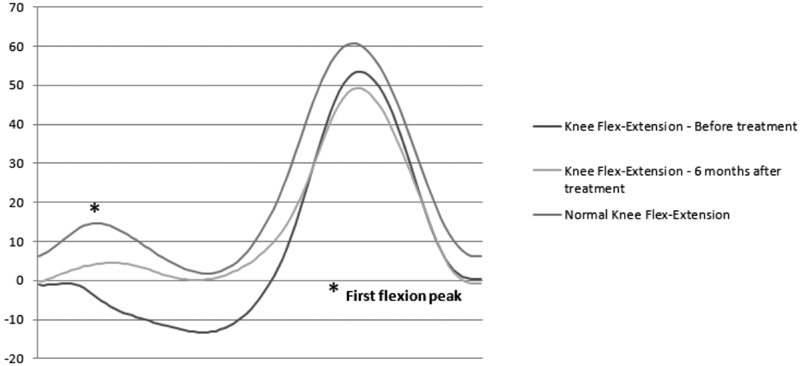We read with great interest the study by Priano titled “Early efficacy of intra-articular HYADD® 4 (Hymovis®) injections for symptomatic knee osteoarthritis.” 1 The author would like to explore the efficacy of intra-articular HYADD 4 (Hymovis) injections for symptomatic knee osteoarthritis. Results from this study are very interesting and promising from a clinical aspect; however, we believe that studying patient's clinical status with visual analog scale and Western Ontario and McMaster Universities Arthritis Index scale should be supported by biomechanical information. From this point of view, to have more data that could influence the clinical practice, it is important to note the possible action that intra-articular injections of different kinds of hyaluronic acid could have on walking biomechanics using an objective measurement tool as gait analysis. In our opinion, the work by Priano 1 is promising because it investigates the efficacy of a new formulation of hyaluronic acid. Nowadays, many hyaluronic acid formulations are approved for clinical use in Europe and the United States. Furthermore, hyaluronic acid injections' efficacy has been demonstrated also in hip osteoarthritis. 2 However, even if these formulations differ in their chemical–physical properties, joint space half-life, rheological properties, and clinical efficacy, there are few studies that investigate hyaluronic acid's possible action from a biomechanical point of view. 3 4 From this point of view, we believe that osteoarthritis management and rehabilitation should be prescribed after an objective analysis of functional walking alterations using gait analysis instrumentations. The use of gait analysis should be desirable during diagnosis and follow-up. In fact, it is capable to identify different walking patterns in patient with osteoarthritis of the lower limbs, whereas the radiology can evaluate the status of the joint's structures. Moreover, gait analysis can find the exact altered phase of the walking cycle, guaranteeing a precise prescription of a rehabilitation program, giving the clinician data about spatial–temporal parameters, kinematic and kinetic alterations, and about the surface electrical muscle activity using surface electromyography. In conclusion, gait analysis is easily applicable to most of the patients, without side effects. Hence, this instrumentation is suitable for follow-up evaluations and permits to assess any variations of walking biomechanics over time.
As an example, we would like to present a case of a patient (female, 42 years old) affected by knee osteoarthritis (II grade—Kellgren and Lawrence classification), treated with two intra-articular injection of mobile reticulum hyaluronic acid, evaluated with gait analysis before treatment and 6 months after the treatment. In our patients is evident the improvement of the flexion–extension kinematic as a consequence of the treatment performed, in particular, we would like to underline the amelioration of the first flexion peak at the loading response phase of the walking cycle ( Fig. 1 ). Finally, we would like to underline how gait analysis could represent very important outcome measurement to determinate the efficacy of intra-articular injection therapy to treat knee osteoarthritis.
Fig. 1.

Knee flexion–extension kinematic.
Funding Statement
Funding None.
Footnotes
Conflict of Interest None.
References
- 1.Priano F. Early efficacy of intra-articular HYADD® 4 (Hymovis®) injections for symptomatic knee osteoarthritis. Joints. 2017;5(02):79–84. doi: 10.1055/s-0037-1603677. [DOI] [PMC free article] [PubMed] [Google Scholar]
- 2.Doria C, Mosele G R, Caggiari G, Puddu L, Ciurlia E. Treatment of early hip osteoarthritis: ultrasound-guided platelet rich plasma versus hyaluronic acid injections in a randomized clinical trial. Joints. 2017;5(03):152–155. doi: 10.1055/s-0037-1605584. [DOI] [PMC free article] [PubMed] [Google Scholar]
- 3.Skwara A, Ponelis R, Tibesku C O, Rosenbaum D, Fuchs-Winkelmann S. Gait patterns after intraarticular treatment of patients with osteoarthritis of the knee--hyaluronan versus triamcinolone: a prospective, randomized, doubleblind, monocentric study. Eur J Med Res. 2009;14(04):157–164. doi: 10.1186/2047-783X-14-4-157. [DOI] [PMC free article] [PubMed] [Google Scholar]
- 4.Tang A C, Tang S F, Hong W H, Chen H C. Kinetics features changes before and after intra-articular hyaluronic acid injections in patients with knee osteoarthritis. Clin Neurol Neurosurg. 2015;129 01:S21–S26. doi: 10.1016/S0303-8467(15)30007-X. [DOI] [PubMed] [Google Scholar]


